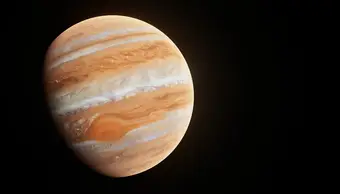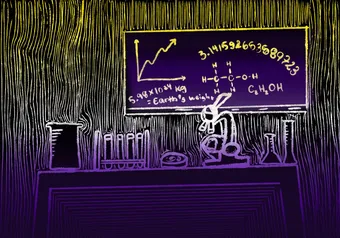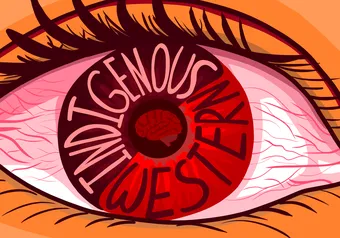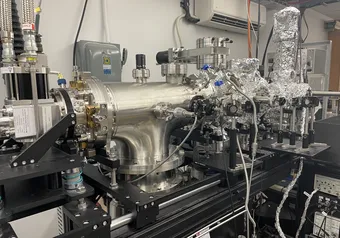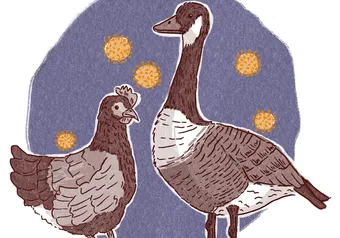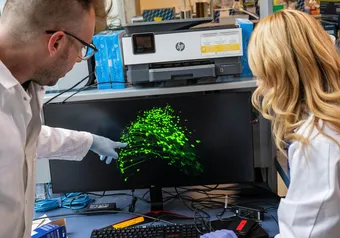At the second Annual John S. MacDonald Outer Space Lecture on September 18, UBC welcomed an acclaimed Canadian-born NASA researcher to discuss her decades-long career at the forefront of space exploration.
Jan Chodas is a NASA icon. She’s enjoyed a successful 40-year career at NASA's Jet Propulsion Laboratory (JPL) and a stint as the Director of Planetary Science before retiring this year. Her leadership as project manager was integral to several NASA projects, including the Juno mission to Jupiter and the Europa Clipper mission to Jupiter’s moon Europa.
The Outer Space Institute welcomed her to UBC with space tech company MDA.
Dr. Tanya Harrison, a fellow Canadian astrophysicist and Outer Space Institute fellow, moderated the talk as Chodas reflected on her out-of-this-world career, shared her hopes for the future and answered audience member’s burning questions about the great beyond.
Jetting into space
The Space Lecture was abuzz with the excitement of space nerds from all walks of life, from first-year students just dipping their toes into the vastness of space education to experts investigating research questions adjacent to Chodas’ work.
Most of Chodas’ talk focused on her time with JPL, a NASA-funded development and research centre managed by CalTech.
JPL’s scrappy beginnings started in the 1930s with a team of young scientists blasting rockets into the sky, and later moved on to missile research and development in the 1940s. In 1958, JPL earned its stripes during the space race and launched Explorer I, the United States’ first satellite.
Today, JPL develops robotic spacecraft for space exploration, with its creations having visited every planet in our solar system and even ventured beyond it.
“Our mission is to explore the solar system and beyond for NASA, the American taxpayers and the world,” said Chodas. “It's really an inspiring place to work … because I really feel like we're on the forefront of space exploration.”
Notable missions for Chodas like Galileo and Juno involve long journeys to Jupiter — an exercise in “delayed gratification.”
To put this into perspective, Harrison explained the difference in awaiting results for space missions. A mission to the moon may take days or weeks, while a Mars mission can take “a little bit of a delay” of six to eight months. But for Saturn and Jupiter, it will take your spacecraft five or six years to reach its target.
“So for some people working on these missions, like the scientists working on Cassini, [this is] probably the only data that they're ever going to get from that planet for [their] entire career,” said Harrison.
Chodas’ Juno mission to Jupiter was launched in 2011 and landed successfully in 2016.
“This is still chugging away 54 orbits or so so far, doing really well. That's been very rewarding,” said Chodas. The Juno spacecraft will be active until September 2025.
She explained that managing these projects required lots of “overengineering” to ensure that spacecraft can function on their own, millions of miles away from Earth.
“JPL can build spacecraft that nobody can touch to try to repair,” said Harrison. “So it's taking you years to get there and then it still works for years and years after… that is absolutely incredible. There's probably no piece of technology that we interact with on a day to day lives, where you could just let it go and never [have to touch again.]”
During her career at NASA, Chodas has also worked on the Cassini mission to Saturn, the Mars Exploration Rover and most recently, she worked as project manager for the Europa Clipper mission, marking her third time to Jupiter.
Shooting for the stars
Born and raised in Ontario, Chodas’ academic career started with her undergraduate and master’s studies at University of Toronto where she studied aerospace engineering.
“I found that I really liked the beauty of the precision of physics, math and space,” she said.
Chodas pursued her graduate studies in dynamics and control of spacecraft during the late 1970s. She reflected on being 1 of 2 women in her master’s cohort of 60 people.
It was in this cohort that she met her biggest supporter and her reason for applying to NASA in the first place: her husband, Dr. Paul Chodas.
It was her then-boyfriend who encouraged a hesitant Chodas to apply for a NASA JPL position. According to Chodas, it felt like a long shot for NASA to accept a Canadian applicant. But 1979 saw a shortage of American aerospace engineers, opening the opportunity for a promising young Chodas to receive an offer at JPL and begin her impressive career. Paul Chodas joined his wife in the United States, and also saw a successful career at NASA.
When asked by an audience member what research question she hopes to have answered at the final frontier, she pointed to a topical one: Is there life elsewhere in the Universe?
Two notable NASA missions that will reveal insight into life on other planets include the Mars Sample Return mission and the Europa Clipper mission. The Mars Sample Return mission is a collaboration between NASA and the European Space Agency and is set to launch in 2027. The project aims to deliver samples from the Mars Rover back to Earth for analysis, with the hopes of uncovering more information about whether life ever lived on Mars.
When asked by a concerned audience member whether Earthlings should worry about a sci fi-level threat brought on by bringing samples from Mars to Earth, Chodas confirmed that all samples will be sterilized. There are also protocols planned to ensure no microbes will be accidentally introduced to Mars from Earth and vice versa.
Deeper into our solar system, scientists are almost certain that Jupiter's moon Europa contains an ocean beneath its icy exterior. “And on earth, everywhere you find water you find life,” said Chodas.
The Europa Clipper mission aims to explore “whether the icy moon could harbor conditions suitable for life,” according to NASA’s website. If Europa does have observational life, this has extraordinary implications for the potential for life to exist beyond our Solar System. The mission is currently planned to launch next year.
When asked by The Ubyssey what skills students should adapt to pursue a similar career in space science, Chodas encouraged them to focus their energy on honing research skills and developing a “reputation for getting stuff done.”
Regarding her most rewarding experience, Chodas’ pointed to her experiences leading a team. The work culture at JPL centers on responsibility, proactivity and teamwork.
“It’s really rewarding. The brain power of the community there is just amazing,” she said.
First online
Share this article


